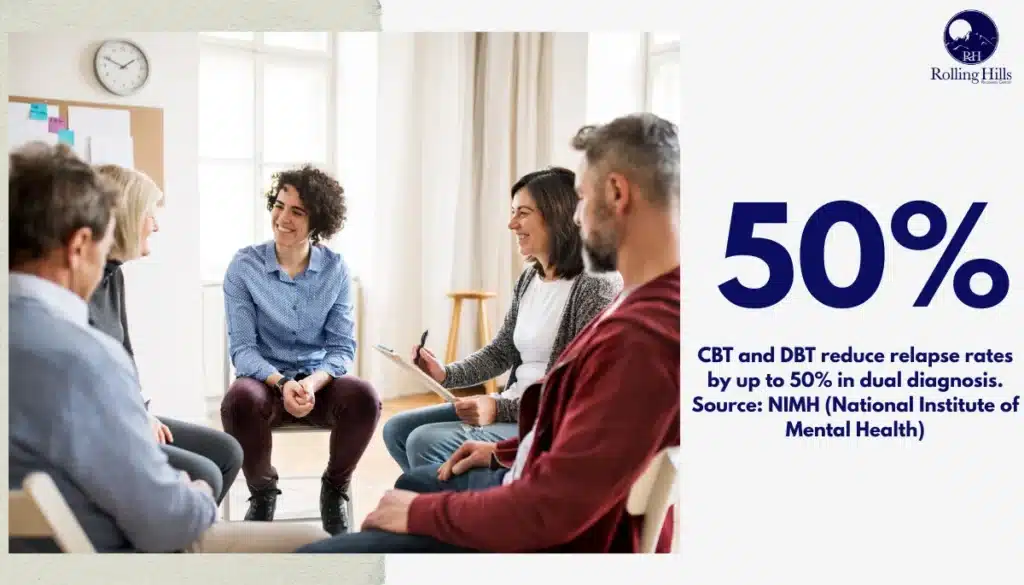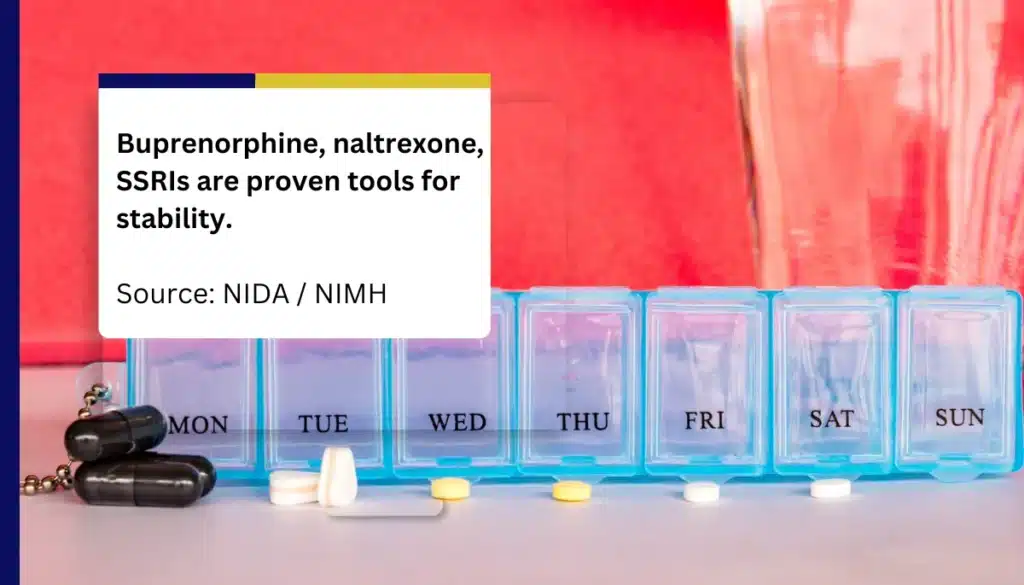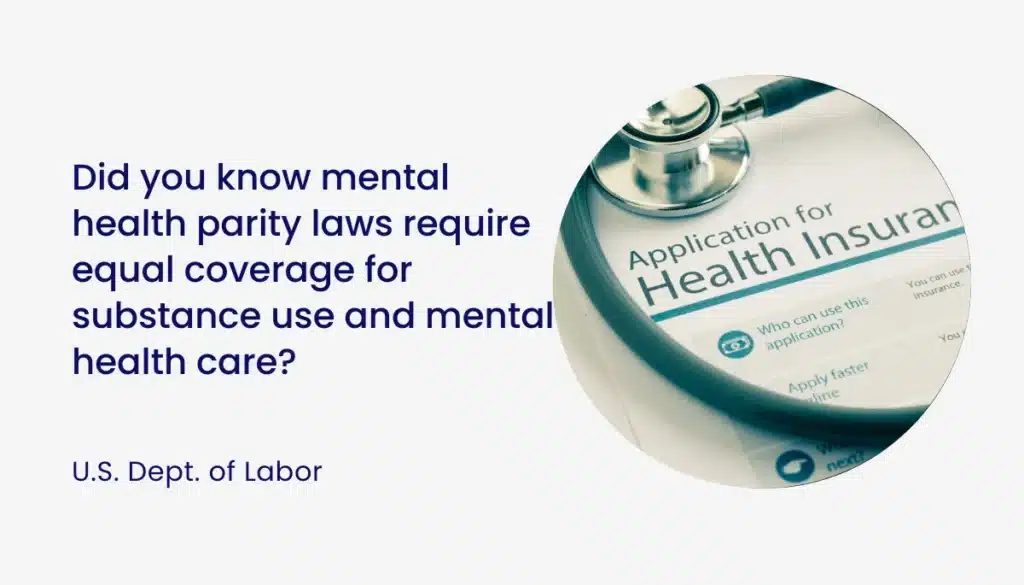Dual diagnosis, when a mental health condition and a substance use disorder occur together, needs coordinated, evidence-based care.
This overview explains how integrated treatment works in New Jersey, what assessments matter, and which therapies and medications support recovery. Expect clear steps, practical tools, and safety tips to help individuals and families move forward with confidence.
Key Takeaways
- Treating mental health and substance use together leads to better outcomes in New Jersey; integrated care lowers relapse and improves daily function.
- Start with safety: screen for risk, use tools like PHQ-9, GAD-7, AUDIT, DAST, do a medical check, manage withdrawal if needed, then therapy & medication (CBT, DBT, Motivational Interviewing, trauma-informed care; buprenorphine, naltrexone, SSRIs when indicated).
- Rolling Hills Recovery Center is a drug and alcohol rehab and addiction treatment center in New Jersey that offers evidence-based addiction treatment and holistic approaches; the experienced team helps people overcome substance abuse and achieve lasting results.
- Insurance and access matter: mental health parity, benefit checks, prior authorization, and 42 CFR Part 2 privacy apply; keep naloxone handy and know 988 for crisis support.
- Plan for the long run—step-down levels of care, medication continuity, family and peer support, sleep, nutrition, and exercise, plus relapse prevention with regular follow-ups.

Definition and Scope of Dual Diagnosis Treatment in New Jersey
Dual diagnosis describes when a person has both a substance use disorder and a mental health condition at the same time. Common pairings include alcohol use disorder with major depression, opioid use disorder with PTSD, stimulant use with anxiety or bipolar spectrum symptoms, and ADHD with cannabis or alcohol misuse.
These conditions influence each other. Substance use may temporarily blunt distress but worsens mood, anxiety, and sleep over time. Mental health symptoms can trigger or reinforce use. Effective care addresses both together.
Integrated treatment, psychiatry plus addiction medicine under one plan, improves outcomes. People are more likely to enter and remain in treatment, develop skills to manage symptoms and cravings, and maintain recovery. It also reduces hospitalizations and overdose risk. Nurses, physicians, therapists, case managers, and peer specialists coordinate across one plan. It is not “mental health first, addiction later,” or vice versa. It is both, at once.
New Jersey-specific considerations:
- Programs providing substance use treatment are overseen by the NJ Division of Mental Health and Addiction Services (DMHAS), which sets licensing standards, quality expectations, and access priorities.
- Mental health parity laws require most health plans to cover mental health and substance use services at levels comparable to medical/surgical benefits.
- NJ FamilyCare (Medicaid) covers many evidence-based services, including medication for opioid use disorder (MOUD), therapy, and case management.
- Crisis access is available 24/7 via 988 (Suicide and Crisis Lifeline). NJ 211 can help with shelter, food, and other social supports that affect recovery.
- Rolling Hills Recovery Center provides evidence-based and holistic treatment in New Jersey, aligning care with state standards while tailoring to individual needs.
What “integrated” looks like in routine care:
- One evaluation covers mental health and substance use, not two separate tracks
- One collaborative plan with detox or stabilization, medications, therapy, and family support
- Medication choices informed by both psychiatric and addiction needs
- Step-down sequencing to sustain progress: residential, IOP, outpatient, then long-term wellness coaching when appropriate

Screening and Assessment Essentials
Early, thorough assessment is the foundation. The first visit sets direction for safety and success.
Step-by-step intake and triage
- Screen for immediate risk:
- Suicidal ideation, intent, plan, past attempts
- Overdose risk (recent nonfatal overdose, fentanyl exposure, benzo co-use)
- Acute withdrawal risk (alcohol, benzodiazepines, opioids), seizure history
- Medical red flags: chest pain, infection, pregnancy, severe dehydration, delirium
- Standardized tools help quantify symptoms:
- PHQ-9 for depression
- GAD-7 for anxiety
- AUDIT for alcohol use risk
- DAST-10 for drug use risk
- PTSD screen (e.g., PC-PTSD-5) when indicated
- Craving rating (0–10) and withdrawal scales (e.g., COWS for opioids, CIWA-Ar for alcohol) as needed
- Medical and psychiatric workup:
- Urine toxicology for baseline; consider breathalyzer as appropriate
- CBC, CMP, liver enzymes; HbA1c, and lipids when psych meds are considered
- Hepatitis C and HIV screening with consent; STI testing when indicated
- Pregnancy testing when applicable
- EKG if starting QT-prolonging meds, methadone, or antipsychotics
- Sleep, pain, nutrition, and physical activity screening
- Differential diagnosis: substance-induced vs primary psychiatric disorders
- Timeline mapping: which symptoms came first? Did symptoms persist during periods of abstinence?
- Intoxication and withdrawal effects can mimic or mask depression, anxiety, or psychosis
- Reassess after stabilization; some diagnoses become clearer once use decreases
- Functional and social determinants assessment:
- Housing stability, transportation, food security, employment, and legal matters
- Support system: family, friends, peer network
- Cultural and identity factors; trauma history; LGBTQIA-specific needs
- Care planning, align intensity to need:
- Alcohol/benzo withdrawal: consider medically supervised detox
- Opioid use disorder: same-day initiation of buprenorphine when appropriate; coordinate with MAT prescribers
- Stabilization with psychiatric medications when indicated
- Psychotherapy scheduling (CBT/DBT-oriented), case management, and peer support
What to include in the initial plan:
- Diagnoses being treated and what is still provisional
- Short-term goals (e.g., “start buprenorphine,” “reduce PHQ-9 by 5 points in 4 weeks”)
- Safety plan and emergency contacts
- Weekly therapy frequency and group involvement
- Medication list with target symptoms and side effect monitoring
- Recovery supports: rides, childcare solutions, and telehealth options

Evidence-Based Care Components
Core Psychotherapies
- Cognitive Behavioral Therapy (CBT): helps identify unhelpful thoughts, triggers, and behaviors. Skills include thought records, craving management, activity scheduling, and problem-solving.
- Dialectical Behavior Therapy (DBT) skills: emotion regulation, distress tolerance, mindfulness, and interpersonal effectiveness are valuable for mood swings, trauma-related distress, and relapse risk.
- Motivational Interviewing (MI): builds change talk, lowers ambivalence, and supports practical next steps. Essential during early engagement and during lapses.
- Trauma-informed care: emphasizes safety, choice, and empowerment. Avoids retraumatization. When appropriate, trauma-focused therapies (e.g., CPT, EMDR) may be integrated after stabilization.
- Contingency management principles: simple, tangible rewards for meeting goals (e.g., negative tox screens, session attendance) can improve engagement.
Templates therapists often use:
- Trigger-thought-craving-action worksheet
- Weekly coping plan (3 skills per day; morning, afternoon, evening)
- Behavioral activation list: 10 brief activities that increase positive reinforcement

Medications for Substance Use Disorders and Mental Health Conditions
Opioid use disorder
- Buprenorphine: partial agonist that reduces cravings and overdose risk. Often started the same day after confirming mild to moderate withdrawal; low-dose initiation (“micro-induction”) can be used when fentanyl exposure is likely.
- Methadone: full agonist provided via certified opioid treatment programs (OTPs) when buprenorphine is not suitable or when higher opioid tolerance is present.
- Extended-release naltrexone: opioid antagonist; requires complete detox from opioids before initiation.
Alcohol use disorder
- Naltrexone (oral or extended-release injection): reduces craving and heavy-drinking days.
- Acamprosate: helps maintain abstinence; dose adjusted for kidney function.
- Disulfiram: aversive agent; best with supervision and clear motivation.
Tobacco and nicotine dependence
- Varenicline, bupropion SR, and nicotine replacement (patch, gum, lozenge) support recovery and improve mood/anxiety over time.
Co-occurring psychiatric conditions
- Depression/anxiety: SSRIs (e.g., sertraline, escitalopram) or SNRIs. Start low and go slow, monitor interactions and hepatic function with alcohol use.
- Bipolar disorders: mood stabilizers (lithium, valproate, lamotrigine) ± atypical antipsychotics.
- PTSD: SSRIs/SNRIs are first-line; prazosin may help nightmares.
- Psychotic disorders: atypical antipsychotics with metabolic monitoring.
- ADHD: careful assessment and staged treatment. Non-stimulants (atomoxetine, guanfacine, bupropion) may be useful; stimulant therapy can be considered with close monitoring. See ADHD and addiction for details.
Medication best practices
- Combine medication with therapy; neither is sufficient alone for most people.
- Use pillboxes or blister packs; set phone reminders.
- Review side effects early; adjust promptly to prevent dropout.
- Check the state Prescription Drug Monitoring Program (PDMP) when controlled meds are prescribed.
Family Involvement and Peer Support
- Family sessions to align expectations, teach communication and boundary setting, and create shared safety plans.
- Education about cravings, overdose prevention, and how to support rather than rescue.
- Peer recovery specialists offer lived experience, practical tips, and low-barrier engagement.
- Encouragement to attend mutual-help groups (12-step, SMART Recovery, Refuge Recovery), choosing what fits the person’s values. No one-size-fits-all.
Simple family meeting agenda
- What’s working this week
- Triggers or conflicts that came up
- One skill to practice together
- Medication and appointment check
- Safety plan review (3 warning signs, 3 coping actions, 3 contacts)
Holistic Supports That Matter
- Sleep: consistent schedule, light exposure in the morning, caffeine limits, CBT-I strategies when insomnia persists.
- Nutrition: regular meals, hydration, and blood sugar stabilization reduce mood swings and cravings.
- Movement: even 10–20 minutes most days improves anxiety, sleep, and cognition. For ideas, see exercise in addiction recovery.
- Mindfulness and breathing drills (box breath, 4-7-8) as rapid reset tools.
- Pain care without escalating risk: physical therapy, non-opioid medications, pacing strategies.
Culturally Responsive Care
Care should reflect each person’s culture, language, faith, and identity. Staff training on cultural humility, trauma, and stigma is essential. For LGBTQIA+ individuals, safe spaces and affirming care reduce barriers and improve engagement. Learn more about local supports at LGBTQIA support in New Jersey.
Telehealth and Hybrid Models
Telehealth improves access when transportation, childcare, or work schedules are tight. Video visits for therapy and medication management can be alternated with in-person check-ins.
Privacy is reviewed beforehand; headphones and a quiet room are recommended. Remote monitoring tools (mood surveys, craving check-ins, reminders) help keep momentum between sessions.

Access, Insurance, and Logistics in New Jersey
Verifying Benefits and Authorizations
- Mental health parity: most plans must cover co-occurring condition care at the same level as medical services. If a medical procedure would not need prior authorization, similar behavioral health services often should not either; if they do, criteria must be comparable.
- NJ FamilyCare (Medicaid): covers many dual diagnosis services, including MAT, therapy, and intensive outpatient. Check plan-specific networks.
- Commercial insurance: call the number on the back of the card. Ask: Do I have out-of-network benefits? Is prior authorization needed for IOP, residential, or MAT? What is my copay or coinsurance?
- If authorization is denied, request the criteria used and consider an appeal with supporting clinical notes (risk level, history of relapse, medical comorbidities).
- Rolling Hills Recovery Center assists with eligibility checks and coordination to reduce delays.
Quick phone script for benefits verification
- “I’m seeking dual diagnosis treatment. Please confirm: in-network providers, prior authorization needs for IOP/residential, coverage for buprenorphine or extended-release naltrexone, therapy visit limits, and deductible/coinsurance amounts.”
Transportation and Practical Supports
- Ask about ride benefits through NJ FamilyCare or your commercial plan’s case management. Many plans offer non-emergent medical transport.
- NJ Transit and local county programs may have reduced fare or paratransit options.
- Consider hybrid scheduling (telehealth plus in-person) to minimize missed sessions.
- Childcare planning: coordinate session times with family or community resources; some programs offer family-friendly scheduling.
Workplace Protections and Leave
- FMLA can provide up to 12 weeks of job-protected leave for eligible employees when treatment is prescribed by a health care provider. Not all employers are covered; eligibility depends on employer size and hours worked.
- Reasonable accommodations under the ADA and New Jersey Law Against Discrimination may include schedule adjustments for therapy or MAT appointments.
- NJ Paid Sick Leave law provides up to 40 hours annually for many workers.
- NJ Temporary Disability Insurance (TDI) may offer partial wage replacement during medically necessary treatment. Confirm eligibility and documentation requirements.
Confidentiality and Records
- 42 CFR Part 2 strictly protects the privacy of substance use disorder treatment records. Disclosure typically requires the patient’s specific written consent.
- HIPAA also applies. Patients may authorize limited information sharing (e.g., medication list, attendance) with families or employers when helpful.
- Explain who will see what. Use releases to coordinate with primary care, psychiatry, and any outside therapists while keeping control with the patient.

Harm Reduction and Overdose Prevention
- Naloxone saves lives. Keep it at home and teach family how to use it. Many NJ pharmacies dispense naloxone without a patient-specific prescription.
- Fentanyl is present in much of the drug supply, including counterfeit pills. Fentanyl test strips are legal in NJ and can inform safer decisions.
- Avoid mixing opioids with benzodiazepines or alcohol. If prescribed, coordinate dosing and watch for sedation.
- Xylazine (“tranq”) may contaminate opioids or stimulants; it increases sedation and can cause skin wounds. Seek medical care early for any wounds or persistent sedation.
- After any overdose or near-miss, rapid MOUD initiation is recommended and supported by evidence.
Naloxone quick steps
- Recognize overdose: unresponsive, slow/absent breathing, blue lips.
- Call 911.
- Give naloxone (spray in one nostril). Repeat in 2–3 minutes if no response.
- Start rescue breathing if needed until help arrives.
Timelines and Metrics to Track Progress
Early stabilization (first 2–4 weeks)
- Start/adjust MAT and psychiatric medications
- 1–2 therapy sessions per week; group skills training if available
- Urine tox monitoring per clinical need; safety plan finalized
Consolidation (1–3 months)
- Skills practice, family sessions, routine check-ins
- Medical comorbidities addressed; sleep and nutrition improved
- Resume or start work/school tasks if appropriate
Maintenance (3–12 months and beyond)
- Relapse prevention plan practiced
- Less frequent visits; peer support; wellness activities
Trackable metrics
- PHQ-9/GAD-7 scores at baseline, 4 weeks, 12 weeks
- Craving intensity and frequency logs
- Attendance and engagement (missed visits)
- Substance use frequency (self-report + tox as appropriate)
- Medication adherence and tolerability
- Quality-of-life indices: sleep hours, energy, social connection, housing stability
Aftercare and Relapse Prevention
Step-Down, Not Drop-Off
Recovery is a continuum. When symptoms stabilize:
- Move from residential/PHP program to intensive outpatient (IOP), then to weekly outpatient
- Keep MAT and psychiatric medications steady unless there is a clear reason to change
- Maintain 12+ weeks of structured care whenever possible; longer engagement improves outcomes
Medication Continuity
- Schedule follow-ups before leaving higher levels of care. No gaps.
- Provide enough refills to bridge to the next appointment.
- Consider extended-release formulations (e.g., monthly naltrexone) when adherence is challenging.
- Monitor interactions and labs as indicated (LFTs for naltrexone/disulfiram; levels for lithium; metabolic monitoring for antipsychotics).
Medication list template
- Medication, dose, time of day
- What it treats
- Common side effects to watch for
- Next lab or EKG date
- Prescriber contact
Safety Planning for Dual Diagnosis
A written plan reduces risk. Keep copies at home and on the phone.
Safety plan steps
- Warning signs: list 3–5 early cues (thoughts, feelings, places)
- Coping skills: 5 options that work in 10 minutes or less
- Contact list: 2 supportive people + provider number
- Environment: remove or lock up alcohol, unused meds, paraphernalia
- Crisis resources: 988, nearest ER/urgent care, naloxone location
- If a lapse happens: call the team, schedule an extra session, review triggers, adjust medications if needed. Fast response prevents relapse.
Building Recovery Capital
- Housing: stable, safe, and free from active use when possible
- Employment or schooling: consider phased returns and supportive supervisors
- Legal/financial: address fines, debts, or court obligations with a case manager
- Community: peer recovery groups, volunteering, and healthy recreation
- Identity-affirming care: for LGBTQIA+ and other communities, affirming providers and spaces reduce isolation and stigma
- Physical wellness: sleep, nutrition, and movement form the base; small wins count. Rolling Hills Recovery Center integrates holistic supports to make habits stick.
Weekly recovery schedule template
- Monday–Sunday grid with:
- Wake/sleep times
- Medication times
- Therapy/groups/peer meetings
- Movement or mindfulness block
- One enjoyable activity daily
- “Red flag” box to note any cravings or mood dips
Coordination with Primary Care and Specialists
- Share a concise summary (diagnoses, medications, allergies, risk flags) with primary care when authorized.
- Manage chronic conditions that worsen mental health (thyroid issues, diabetes, sleep apnea, chronic pain).
- Dental health after stimulant or alcohol use is important; dental pain can trigger cravings.
- Pregnant patients require coordinated OB care; MAT is recommended in pregnancy for opioid use disorder.
Digital Check-Ins and Outcomes Monitoring
- Short weekly surveys via text or app: mood (0–10), cravings (0–10), sleep hours, medication taken (yes/no)
- Automatic flags if scores drop or cravings rise; prompt a quick call or brief visit
- Telehealth booster sessions after high-risk events (anniversaries, court dates, grief reminders)
- Consider verified digital CBT/DBT tools between sessions to reinforce skills
Personal relapse-prevention plan
- My top 3 triggers
- 5 skills I can do in 10 minutes
- 3 people I can contact
- What I will say when offered substances
- How I will repair my day after a lapse
References and Tools for Clinicians and Families
- SAMHSA: Co-Occurring Disorders – definitions, screening, and integrated care models
- NIMH: Mental Health Medications – indications, side effects, and monitoring
- NJ DMHAS Services – licensing, program directories, and statewide initiatives
- NIDA: Principles of Effective Treatment – evidence-based components and retention strategies
Practical tools you can adapt
- PHQ-9 and GAD-7 printable forms for routine outcome monitoring
- AUDIT and DAST for initial risk stratification
- Columbia Suicide Severity Rating Scale (C-SSRS) when indicated
- COWS/CIWA-Ar for withdrawal assessment
- Naloxone training videos from public health agencies; keep a kit at home
- A “one-page care plan” summarizing diagnoses, medications, emergency contacts, and the safety plan, easy to share with authorized providers
Rolling Hills Recovery Center’s approach
- Integrated, evidence-based treatment with psychiatric and addiction specialists working together
- Personalized medication plans (buprenorphine, naltrexone, acamprosate, and appropriate psychiatric medications) with careful monitoring
- CBT/DBT skills, Motivational Interviewing, trauma-informed care, and family involvement
- Holistic supports: sleep coaching, nutrition basics, and sustainable movement
- Hybrid in-person and telehealth options to match real-life schedules
For people who want educational content beyond this page, our resource library includes topics like top 10 most addictive drugs, which can help families understand risk and urgency.
Conclusion
Integrated care for dual diagnosis in New Jersey works best. Key takeaways: early screening and safety first; evidence-based therapy plus medications; strong aftercare, family support, and mind & body habits. If ready, confirm insurance, schedule an assessment, keep naloxone on hand.
Rolling Hills Recovery Center is a drug and alcohol rehab and addiction treatment center in New Jersey offering evidence-based and holistic approaches. The team’s experience helps people overcome substance use and achieve lasting results.
Frequently Asked Questions (FAQs)
What is Dual Diagnosis Treatment in New Jersey, and Who Benefits?
Dual diagnosis treatment in New Jersey addresses a mental health condition and a substance use disorder at the same time.
It benefits people who notice mood changes, anxiety, trauma symptoms, or psychosis alongside alcohol or drug misuse.
When both problems occur together, treating just one often isn’t enough; integrated care reduces relapse risk and improves daily function.
What Happens First During Dual Diagnosis Treatment in New Jersey?
Care usually starts with a full assessment: safety and overdose risk, a medical review, and simple screens like PHQ-9, GAD-7, AUDIT, or DAST. Lab tests may check meds and health basics. If withdrawal risk is present, medically supervised detox comes first.
Next, a team builds a plan that combines therapy & medication, plus sleep, nutrition, exercise, and family support. Coordination continues across levels of care so people aren’t bounced between services.
Which Therapies and Medications Are Common in Dual Diagnosis Treatment in New Jersey?
Evidence-based therapies include CBT & DBT, Motivational Interviewing, and trauma‑informed care. For opioid use disorder, buprenorphine or naltrexone may be used; for alcohol use disorder, naltrexone or acamprosate are common.
Antidepressants (like SSRIs or SNRIs), mood stabilizers, or atypical antipsychotics may be added when indicated. Good care in dual diagnosis treatment in New Jersey also includes relapse prevention skills, sleep hygiene, and careful medication monitoring.
Is Insurance Accepted for Dual Diagnosis Treatment in New Jersey?
Most programs verify benefits and work with commercial plans and Medicaid. Mental health parity laws generally require comparable coverage for dual diagnosis treatment in New Jersey.
Prior authorization may be needed; bringing an ID, insurance card, and a medication list usually speeds things up. Privacy protections (including 42 CFR Part 2) help keep substance use treatment information confidential.
How Does Rolling Hills Recovery Center Approach Dual Diagnosis Treatment in New Jersey?
Rolling Hills Recovery Center delivers dual diagnosis treatment in New Jersey with a blended model: evidence-based therapies, medication management, and holistic supports.
Rolling Hills Recovery Center is a drug and alcohol rehab and addiction treatment center in New Jersey that offers evidence-based addiction treatment and holistic approaches. The team of experienced professionals is dedicated to helping individuals overcome substance abuse and achieve lasting results.
Care plans include CBT & DBT, medication for alcohol or opioid use disorders when appropriate, skills for mood and anxiety, plus family involvement and aftercare so gains stick.
Author
-
Our editorial team includes licensed clinicians and board-certified addiction specialists. Every article is written and reviewed to be clear, accurate, and rooted in real treatment experience.
View all posts -
Dr. Williams has held senior leadership positions in the behavioral health field for over 30 years. He has worked with diverse populations in various private and public sectors.
View all posts












